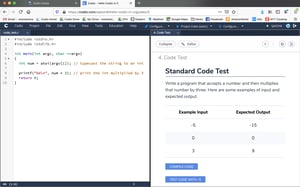Flexibility has become a key component of teaching in a world of hybrid and remote learning. Some instructors who have had to alter their teaching style to accommodate distance learning have encountered technical issues along with challenges maintaining student engagement.
As educators begin a new semester, Codio's Patrick Ester recently demonstrated interactive instruction tools and resources in our on-demand webinar. Find a sneak peek of Flexible Computing Education in an Uncertain Semester, Patrick's informative presentation, below.
“[Research] shows greater student retention and performance when faculty members become more engaged with classroom materials.”
- Open Textbook Alliance
Flexible, ready-to-Go Curriculum Resources
Educators can provide engaging virtual learning environments by creating or utilizing pre-built flexible computing resources. Codio offers a robust resource library of interactive, editable course resources, Open Educational Resources (OERs), and licensed textbooks for data and computer science educators. Any resource can easily be added to a course in Codio and edited to fit the instructor’s needs. Modules and chapters from any resource can be mixed-and-matched to provide a truly customized experience.
Codio’s flexible computer science trajectory was specifically designed for easy integration into our online IDE. Our platform offers ample opportunity for hands-on learning in introductory CS concepts, such as:
...and more!
Computer Science Educator Concerns
In 2019, Codio conducted an extensive survey to pinpoint the challenges computer science educators face in and out of the classroom. The results showed that challenges range from technical to administrative and include:
-
92% of educators spend too much time acting as tech support for their students
-
53% of educators are concerned with low levels of student engagement and course satisfaction
-
57% of educators say they struggle to provide feedback to students in a timely manner
-
72% of educators are overwhelmed by manual grading
-
47% of educators teach classes with 50 or more students, and 56% say they’re concerned about rising student-to-teacher ratios
Many of these concerns have been amplified by the necessary shift to remote and hybrid instruction in 2020. In Flexible Computing Education in an Uncertain Semester, Patrick Ester presents tools and resources to help CS educators alleviate their concerns and provide an engaging remote learning experience.
Address Tech Concerns with Stacks
Our survey results indicate that playing a technology support role is a concern for almost every CS educator, regardless of class size. Codio’s online IDE allows you to start coding straight from any browser without the trouble of having to set up servers. This makes it simple for instructors and students alike. The platform is accessible from any device, including Macs, PC, and even Chromebooks.
Additionally, with full sudo and terminal access, any software compatible with Ubuntu can be installed in Codio. To make the process even easier, we’ve created Codio stacks. By snapshotting your box, you can create an instantly deployable custom software stack for your students or team. Plus, there is no need to worry about the hassle of having students install software on different machines. Codio offers prebuilt, flexible computer science stacks, such as C++, Java, Python, Ruby, and more, but you can also create your own to fit your exact needs.

Improve Student Engagement with Hands-On Learning
Students unable to follow concepts are likely to lose valuable engagement with their course materials. Instructors using Codio can embed rich images, interactive animations, and even videos throughout lessons to demonstrate high-level concepts and processes for students. These concepts are broken down piece-by-piece in the code visualizer, which shows students how code from the IDE is executed.
Codio features a fully-functional cloud-based IDE, so students can experiment, practice, and see how code functions. Instructors can also use Flode to demonstrate concepts using blocks. Flode looks like pseudo-code and runs executable code piece-by-piece. It presents an interactive opportunity to break down algorithms and demystify the coding process.

Save Time with Auto-Grading
Editable auto-graded assessments from Codio’s global assessment library are available for instructors to use as formative checkpoints or summative assessments. Auto-graded assessments save instructors time otherwise spent on manual grading. They provide a seamless, scalable option to reduce administrative workload and allow educators to focus on providing meaningful feedback to students.
Instructors can also add standard flexible code tests to their courses, which don’t require any scripting to create. Lastly, Codio has the flexibility to allow instructors to import their own grading scripts.

Improve the Quality of Remote Feedback
Remote learners, unfortunately, do not get the same over-the-shoulder guidance that they might in a traditional classroom. That’s why Codio has developed collaborative tools that help instructors provide actionable feedback for students. Any auto-graded assessment can give instantaneous feedback to students regardless of a correct or incorrect answer.
If instructors prefer to work with students one-on-one to resolve issues synchronously, Cursor Presence identifies users’ cursors in the same code file. This way, students and instructors can easily spot where others are working in the same file, much like you can in a Google Doc. Instructors who prefer to leave feedback on their own time can easily do so with Codio’s asynchronous tools, Code Playback, and In-Line Code Commenting. Code Playback enables instructors to replay student code construction so that it is easy to pinpoint where students are running into trouble.
Instructors can then use In-Line Code Commenting to leave commentary or instruction for students. They'd simply highlight the code they’re referencing, then leave a comment on top of the code file. Students won’t have to scan through their code to identify instructor notes and can quickly reply if they need further clarification.

Learning Flexible Computing Insights
Instructors worried about growing class sizes can gain better insight into their students’ performance with Learning Insights. By translating student learning data into powerful visualizations, Codio provides student, assignment, module, and class-level dashboards that give instructors actionable insights across all areas of student learning. This includes any auto-graded assessments.
This information allows instructors to quickly identify which students perform well and those who need more support understanding course material. Challenging modules or assignments are also easy to determine based on overall class performance and might even inform needed curriculum changes for future semesters.

Don’t let the spring semester’s uncertainty get in the way of providing an engaging learning experience for your students! To see these features in action, watch our on-demand webinar, Flexible Computing Education in an Uncertain Semester. When you sign up to access the webinar, you’ll also receive a PDF of the presentation.
See Codio for yourself! Create a free instructor account and edit or evaluate any of our interactive course resources.
FAQ
What is Flexible Computing?
Flexible computing is a way of computing that allows for a tradeoff between the quality of results and the allocation of resources such as time, memory, or information. It can also refer to the use of flexible computer technology to run computationally intensive tasks. In recent years, it has become increasingly important in educational settings as more educators have begun incorporating digital learning tools into their course materials.
What is Cloud Computing in Simple Terms?
The easiest way to explain cloud computing is to think of it as a way for people to access computing services over the Internet aka "the cloud". The public cloud is made up of a network of powerful and secure computing resources. This includes servers, storage, databases, networking, and software–plus analytics and intelligence capabilities that help organizations take advantage of the latest technology advancements.
These flexible cloud computing services can be used for a variety of different purposes such as hosting websites, creating applications, or storage. Cloud computing effectively eliminates the need to purchase and manage physical hardware.
Cloud computing also provides the means for more innovative, flexible, and cost-effective computing solutions. Businesses are able to scale up or down their resources as needed, with only the pay for what they use. This helps businesses optimize their costs and future-proof their investments by leveraging the latest technology advancements.
What is Flexibility in the Cloud?
Flexibility in the cloud is the ability to access computing power, data, and applications without having them stored on physical hardware. It enables businesses to provision resources quickly and efficiently with minimal maintenance effort. This helps reduce upfront costs and time-to-market for services.
Why is Cloud a Flexible Solution?
With a flexible cloud, businesses can scale up or down their resources as needed with minimal effort. This helps optimize costs and future-proof investments by leveraging the latest technology advancements. Additionally, a flexible cloud also provides access to data from anywhere in the world, which makes it easier for users to work on projects in real-time.





